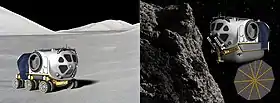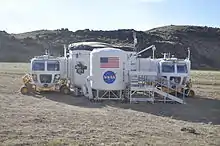Space Exploration Vehicle
The Space Exploration Vehicle (SEV) is a modular vehicle concept developed by NASA. It would consist of a pressurized cabin that can be mated either with a wheeled chassis to form a rover for planetary surface exploration (on the Moon and elsewhere) or to a flying platform for open space missions such as servicing satellites and missions to near-Earth asteroids.[1] The concept evolved from the Lunar Electric Rover (LER) concept, which in turn was a development of the Small Pressurized Rover (SPR) concept.[2]
| Space Exploration Vehicle | |
|---|---|
 Artist's concept of the Space Exploration Vehicle as a wheeled rover on the Moon (left) and as a free-flying spacecraft hovering over an asteroid's surface | |
| Overview | |
| Manufacturer | NASA |
| Also called | Lunar Electric Rover |
| Body and chassis | |
| Class | Rover |
| Doors | 4 |
| Powertrain | |
| Range | 125 km (78 mi) |
| Dimensions | |
| Wheelbase | 4 m (160 in) |
| Length | 4.5 m (180 in) |
| Height | 3 m (118.1 in) |
| Curb weight | 4,000 kg (8,818 lb) |

Concept vehicles of the Lunar Electric Rover (and later, the SEV) were tested during the Desert Research and Technology Studies in 2008,[2] 2009,[3] 2010[4] and 2011.[5][6][7] One of the LER concept vehicles took part in the presidential inauguration parade of Barack Obama in 2009. The chassis and structural elements of these concept vehicles were fabricated by Off-Road International.[8] Research and testing continued in 2012 in the Johnson Space Center with a mock-up of a free-flying SEV simulating a mission to an asteroid.[9]
Development of the SEV has continued, producing variants called the Multi-Mission Space Exploration Vehicle (MMSEV) and in 2013 a cabin for a possible lunar lander called the Alternate MMSEV (AMMSEV).[10]
The SEV is developed together with other projects under the Advanced Explorations Systems Program. The program's budget for FY 2010 was $152.9 million.[11]
Features
The SEV is the size of a small pickup truck, it has 12 wheels, and can house two astronauts for up to two weeks.[12] The SEV consists of a chassis and cabin module.[13] The SEV will allow the attachment of tools such as cranes, cable reels, backhoes and winches.[13] Designed for 2, this vehicle is capable of supporting 4 in an emergency.[13] With wheels that can pivot 360 degrees, the SEV is able to drive in any direction.[13] Astronauts can enter and exit without space suits directly from an airlock docking hatch, or through a suitport without the need to depressurize the habitat module.[13]
The pressurized module contains a small bathroom with privacy curtains and a shower head producing a water mist for sponge baths.[14] It also contains cabinets for tools, workbench areas and two crew seats that can fold back into beds.[14]
Specifications

- Speed: 10 km/h (6 mph)
- Range: 125 km (78 mi)
SEV
- Mass: 3,000 kg (6,614 lb)
- Payload: 1,000 kg (2,205 lb)
- Length: 4.5 m (180 in)
- Wheelbase: 4 m (160 in)
- Height: 3 m (120 in)
- Wheels: 12 cm (4.7 in) x 99 cm (39 in) in diameter, 30 cm (12 in) wide
Chassis
- Mass: 1,000 kg (2,205 lb)
- Payload: 3,000 kg (6,614 lb)
- Length: 4.5 m (180 in)
- Wheelbase: 4 m (160 in)
- Height: 1.3 m (51 in)
- Wheels: 12 cm (4.7 in) x 99 cm (39 in) in diameter, 30.5 cm (12.0 in) wide
See also
References
- NASA's Space Exploration Vehicle (SEV)
- "Three Days in the Desert Tests Lunar "RV"". NASA. December 3, 2008.
- "Desert RATS 2009 14-Day Analog Mission". NASA. November 8, 2010.
- "Desert RATS 2010 Complete 13th Annual Field Test". NASA. April 8, 2011.
- "Desert RATS 2011". NASA. July 8, 2011.
- "Desert RATS 2011: Wrap-up Report". NASA. September 26, 2011.
- "D-RATS Set Sights on Asteroid". NASA. September 30, 2011.
- "Steel Chassis Lets Space Vehicles Traverse Grueling Terrain". Tech Briefs. 1 November 2015. Retrieved 30 June 2017.
- "2012 Research and Technology Studies Resume at JSC". NASA. January 18, 2012.
- Howard, Jr., Robert L. (January 22, 2014). "An Alternate Configuration of the Multi-Mission Space Exploration Vehicle" (PDF). NASA. JSC-CN-30087. Cite journal requires
|journal=(help) - "NASA's Budget: Advanced Explorations Systems Program".
- "NASA's New Lunar Electric Rover (LER)". NASA. Retrieved 2009-09-29.
- "Lunar Electric Rover Concept" (PDF). NASA. Retrieved 2009-09-29.
- "How Lunar Rovers Work". howstuffworks. Retrieved 2009-09-29.
External links
| Wikimedia Commons has media related to Space Exploration Vehicle. |